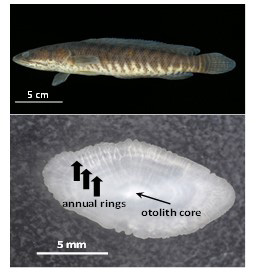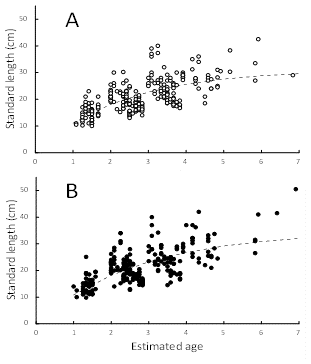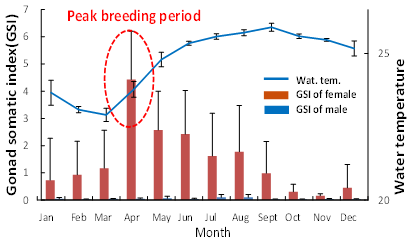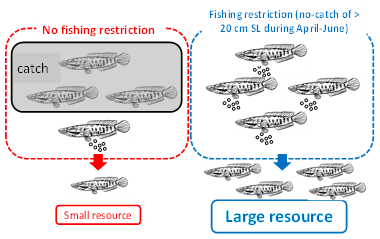Resource management and conservation of Pa koh, an important edible fish in Laos, based on ecological information
Description
Laos has been experiencing a high population growth rate in recent years, resulting to the expansion of urban areas and a rapid increase in demand for edible fish. This has become a serious concern as it has led to a declining stock level of many fish species and a downsizing of the specimens. The snakehead fish, locally called Pa koh (Channa striata) (Fig. 1), is among those facing strong fishing pressure because of its daintiness and high market value. This species is strongly carnivorous, has a superior position in the regional food chain, and its population size is relatively small compared to other non-carnivorous fishes. This situation necessitates stock management of the species and require conservation of the adult specimens (breeding population).
Against this background, an analysis of several ecological features such as age, growth, and reproduction were carried out in the present study using 530 specimens collected from the northern area of Vientiane Province, Laos, and the following findings relevant to efficient stock management were obtained.
- In the otoliths of Pa koh, a translucent zone is formed once per year and a ring structure is deposited (Fig. 1). This ring is an annual ring and it is useful for estimating the ages of each specimen.
- By counting the number of annual rings, the growth models (age–size relationships) are regressed, and the reproductive age and longevity can be estimated. The maximum age and size observed in the present study are 6–7 years old and approximately 50 cm standard length (SL), respectively, for both females and males (Fig. 2).
- The growth patterns of females and males are not significantly different from the growth models (von Bertalanffy growth curves) (Fig. 2), and the model indicates slower growth compared to the growth of C. striata studied in other tropical areas (e.g., Sri Lanka).
- On the basis of the growth model, gonad somatic index (GSI, gonad weight / body weight × 100 %), and size-GSI relationship (figure omitted), this species was found to sexually mature at approximately 20 cm SL (2 years old). Ovary maturation progresses from the late phase of the dry season (March) as the water temperature rises, the peak of reproduction being in April (Fig. 3).
- In order to manage / conserve Pa koh stock, fishing restriction on specimens larger than 20 cm SL during breeding period (from April to June) must be imposed. Setting a non-fishing period and/or non-fishing area(s) in breeding area(s) is considered efficient.
In addition to the above findings, the following observations were noted.
- Since several populations of Pa koh are widely distributed over Laos, further investigations on other populations in other areas are required for stock management in more widespread areas.
- Juveniles of Pa koh (4-5 cm SL) abundantly occur in the shallow area(s) of ponds/lakes/rivers, and they are also caught as edible food. It is also necessary that such activity be controlled for better stock management of Pa koh.
Figure, table
-
Fig. 1.Top: An adult Pa koh (24 cm SL); Bottom: Otolith and annual rings
-
Fig. 2. Growth models of Pa koh (A: female; B: male)
-
Fig. 3. Seasonal changes in the GSI of Pa koh and in water temperature.
-
Fig. 4. Images showing the effects of unrestricted and restricted fishing
- Affiliation
-
Japan International Research Center for Agricultural Sciences Fisheries Division
- Research project
- Program name
- Term of research
-
FY2016(FY2011~FY2015)
- Responsible researcher
-
Morioka Shinsuke ( Fisheries Division )
KAKEN Researcher No.: 40455259Vongvichith Bounsong ( Living Aquatic Resources Research Center, Lao PDR )
- ほか
- Publication, etc.
-
Morioka S et al. (2016) Aquaculture Science 64(2): 183-191.
- Japanese PDF
-
A4 351.26 KB
A3 274.72 KB
- English PDF
-
A4 734.64 KB
A3 633.32 KB
- Poster PDF
-
Poster 370.58 KB




